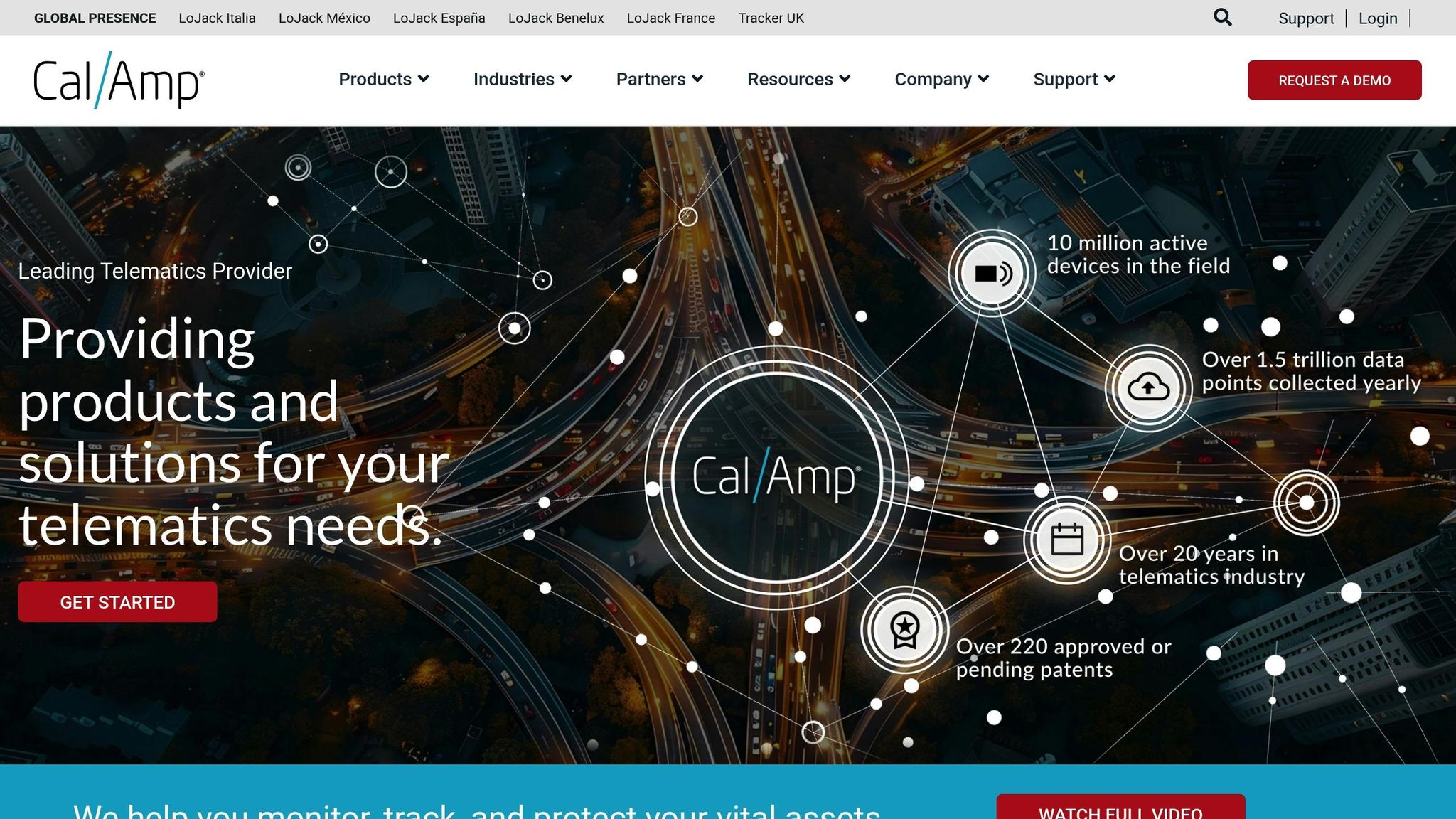5 Benefits of Real-Time Driver Alerts for Fleets
Explore the advantages of real-time driver alerts for fleets, enhancing safety, reducing costs, and improving customer service in UK operations.

Real-time driver alerts help fleet managers address safety, efficiency, and compliance challenges instantly. These alerts notify managers of risky driving behaviours, vehicle misuse, or potential incidents in real time, allowing immediate action. For UK fleets, this technology is particularly useful for meeting strict road safety regulations, reducing costs, and improving customer service.
Key Benefits:
- Improved Safety: Instant feedback on speeding, harsh braking, and other risky actions reduces accidents and supports compliance with UK laws.
- Cost Savings: Alerts encourage fuel-efficient driving, reduce maintenance needs, and lower insurance premiums.
- Better Driver Performance: Continuous feedback fosters safer habits and accountability while enabling targeted training.
- Faster Incident Response: Immediate notifications during accidents or theft help resolve issues quickly and minimise losses.
- Enhanced Customer Service: Real-time tracking ensures timely deliveries, accurate updates, and better reliability.
For UK businesses, adopting real-time alerts is a practical way to improve fleet performance while staying compliant and cutting costs. Systems like GRS Fleet Telematics offer tools starting at £7.99/month, making them an affordable choice for safer, more efficient operations.
Reduce risky driving behaviors with near-real time alerts | iOn Vision | CalAmp

1. Better Fleet Safety
Real-time driver alerts play a key role in improving fleet safety by identifying risky driving behaviours and providing instant feedback. These alerts can notify drivers when they exceed speed limits, brake harshly in traffic, accelerate too quickly, take corners too sharply, or even use vehicles without proper authorisation. By continuously monitoring such behaviours, fleet managers can step in immediately to address potential safety issues before they escalate into accidents.
Beyond improving safety, this level of monitoring also helps fleets stay compliant with UK regulations. With stricter enforcement of speed limits and harsher penalties for commercial vehicle violations, these alerts can help businesses avoid fines and maintain their operator licences. Additionally, managers can demonstrate to the Driver and Vehicle Standards Agency (DVSA) that they are actively monitoring and improving driver behaviour - an important factor in meeting licensing requirements.
The data collected through real-time alerts also enhances driver training. Instead of relying on general feedback during meetings, managers can address specific incidents. For example, if a driver frequently triggers harsh braking alerts during rush hour, they can be coached on maintaining safer distances in traffic. Similarly, a driver with repeated speeding notifications might benefit from additional training on route planning and better time management.
This technology also supports duty of care responsibilities by ensuring drivers take required rest breaks and don’t exceed their legal driving hours. Alerts can notify managers when a driver is nearing their maximum hours, allowing for timely intervention to prevent fatigue-related accidents. This not only protects the driver and other road users but also ensures compliance with the Working Time Regulations.
Ultimately, real-time alerts encourage a culture of accountability. With consistent monitoring, drivers tend to adopt safer habits, leading to fewer accidents, reduced insurance claims, and an overall stronger safety record for the fleet.
2. Lower Costs and Better Efficiency
Real-time alerts play a big role in cutting costs by helping reduce fuel consumption, maintenance expenses, and inefficiencies. By providing instant feedback on driving behaviour, these alerts encourage smarter, more efficient driving habits that can significantly lower running costs.
Driving efficiently doesn’t just improve safety - it also saves money. Keeping an eye on factors like acceleration, speed, and idling allows for timely reminders that promote fuel-saving, smoother driving. This reduces strain on the engine and lowers maintenance needs. For instance, alerts about aggressive acceleration or excessive idling prompt drivers to adjust, improving fuel economy and reducing wear on vehicle parts.
These alerts also make route optimisation easier. Drivers can be instantly informed of traffic jams or road closures, helping them avoid delays and save both time and fuel. On top of that, real-time monitoring helps fleet managers spot unauthorised vehicle use, ensuring vans are only used for approved tasks - cutting down on unnecessary costs.
The data collected through these systems also supports predictive maintenance by scheduling services based on actual usage, which can prevent costly breakdowns. Plus, improved driving practices, backed by documented data, can even lead to lower insurance premiums.
When combined with GRS Fleet Telematics' van tracking solutions, these real-time monitoring features take cost control and operational efficiency to the next level.
3. Better Driver Performance and Accountability
Real-time driver alerts play a key role in promoting safer driving habits. When drivers are aware their actions are being monitored and receive immediate feedback on their performance, it naturally encourages more responsible behaviour behind the wheel.
These instant alerts address unsafe actions like speeding, harsh braking, or sharp cornering as they happen. This real-time coaching allows drivers to adjust their actions immediately, fostering safer habits over time. By creating a system of continuous feedback, it builds a culture where accountability becomes second nature.
Performance monitoring drives accountability. When drivers know their actions are tracked, they're more likely to respect speed limits, maintain safe distances, and avoid risky manoeuvres. This isn’t just about correction - it’s about cultivating a mindset where safe driving becomes the norm.
The data collected by these systems gives fleet managers a clear view of each driver's behaviour. Instead of waiting for complaints or accidents to highlight issues, managers can identify and address patterns of concern early on. This proactive approach not only reduces risks but also supports better decision-making.
Equally important is recognising and rewarding safe driving. Performance data makes it easier to identify drivers who consistently demonstrate good habits, enabling managers to acknowledge their efforts through rewards or professional growth opportunities. Highlighting positive performance is just as crucial as addressing areas for improvement.
Moreover, this transparency benefits drivers too. Clear, documented feedback offers validation for their safe practices, boosting morale and reinforcing good habits.
4. Faster Incident Response and Evidence Collection
Real-time alerts are changing the game when it comes to incident response and collecting evidence, making fleet operations safer and more efficient. When accidents happen or vehicles are stolen, immediate notifications transform the response process. Instead of waiting to react, fleet managers can take proactive steps - dispatching assistance, contacting emergency services, or initiating recovery efforts - without the delays traditionally associated with such situations. This quick detection not only ensures a faster response but also guarantees that crucial data is captured right away.
Vehicle theft is a prime example of how real-time alerts can make a difference. If a vehicle moves outside authorised hours or leaves its designated area, modern telematics systems detect it instantly. This allows fleet managers to act quickly, often making the difference between recovering the vehicle or losing it entirely.
These systems also automatically log critical data during incidents, such as exact location, speed, and timestamps. This documentation happens in real-time, capturing everything from the lead-up to the incident to its immediate aftermath. Such precise records are invaluable for insurance claims, legal cases, and internal reviews, giving fleet managers a clear and unbiased timeline of events. By eliminating guesswork, these records streamline incident reconstruction and help insurers process claims more efficiently.
For stolen vehicles, companies like GRS Fleet Telematics showcase how effective these systems can be. Their dual-tracker technology, paired with 24/7 recovery support, achieves an impressive 91% recovery rate. This highlights how immediate theft detection and rapid response protocols can significantly reduce losses.
Quick responses also help minimise financial impacts. Acting swiftly can prevent secondary costs such as disruption fines, prolonged downtime, or increased insurance premiums. When fleet managers can address issues within minutes rather than hours, they often stop minor problems from spiralling into major operational setbacks.
5. Better Customer Service and Reliability
Real-time driver alerts play a key role in ensuring deliveries are consistent and punctual, meeting the expectations of customers. With the ability to monitor driver behaviour and vehicle performance as it happens, fleet managers can address potential issues before they escalate into problems that affect customers.
Monitoring route adherence is another crucial tool for maintaining delivery schedules. When deviations or delays occur, alerts notify dispatchers immediately, allowing them to contact customers with accurate updates instead of leaving them in the dark. In the highly competitive UK market, this level of proactive communication can prevent minor hiccups from turning into major service failures. It’s a practical approach that works alongside other measures to keep deliveries running smoothly.
The system also helps nip small issues in the bud. For instance, if a driver is braking harshly or taking longer breaks than planned, alerts enable managers to step in quickly and correct the situation before it leads to delays or customer complaints.
Real-time tracking also sharpens delivery estimates. Instead of vague time slots like 09:00 to 17:00, businesses can provide more accurate delivery times and keep customers updated as conditions change. This transparency builds trust and allows customers to organise their day more efficiently.
During peak periods, real-time monitoring ensures resources are allocated effectively to meet customer commitments, even when unexpected challenges arise.
The benefits of reliability stretch far beyond individual deliveries. Consistently meeting delivery promises enhances a company’s reputation, leading to higher customer retention and positive word-of-mouth referrals - an invaluable edge in service-driven industries.
In busy urban areas, real-time alerts are especially useful for navigating traffic restrictions, low-emission zones, and unpredictable road conditions. Immediate notifications about route changes or delays help drivers adjust quickly, keeping deliveries on schedule.
GRS Fleet Telematics equips fleet managers throughout the UK with advanced tools for real-time tracking and driver alerts, boosting service reliability and improving customer satisfaction.
Conclusion
Real-time driver alerts have become a game-changer for modern UK fleets, offering safer operations, lower costs, and improved efficiency. Fleets adopting these systems quickly notice changes like better driving habits, fewer incidents, and happier customers.
Beyond improving safety, these alerts help fleets save money. Advanced telematics systems cut fuel costs, support predictive maintenance, and reduce insurance premiums by encouraging safer driving and minimising claims.
For fleet managers, these systems offer a clearer view of operations, shifting from reactive problem-solving to proactive management. Whether it’s addressing harsh braking, route changes, or unauthorised vehicle use, real-time alerts create accountability and streamline daily operations. This proactive approach also reinforces a commitment to delivering excellent customer service.
Transparency and reliability are key to meeting customer expectations, and real-time alerts help fleets maintain the high standards that foster long-term loyalty.
For UK fleets looking to take advantage of these benefits, GRS Fleet Telematics provides robust tracking solutions starting at just £7.99 per month. Their dual-tracker technology, combined with a 91% recovery rate for stolen vehicles, ensures safer and more efficient fleet operations.
Investing in real-time driver alerts isn’t just about cutting costs - it’s about staying competitive in a fast-paced industry while prioritising safety and service excellence.
FAQs
How can real-time driver alerts help reduce fleet operating costs?
Real-time driver alerts play a crucial role in cutting fleet operating costs by tackling inefficient driving habits like harsh braking, rapid acceleration, and excessive idling. By encouraging smoother driving techniques, these alerts help lower fuel usage and reduce vehicle wear and tear, leading to savings on maintenance.
On top of that, these alerts support smarter route planning, enabling drivers to steer clear of traffic jams or avoidable detours. This not only saves valuable time but also cuts fuel expenses and boosts overall productivity. Together, these improvements pave the way for more efficient and cost-effective fleet operations.
How can real-time driver alerts help fleets comply with UK regulations?
Real-time driver alerts play a crucial role in keeping fleets aligned with key UK regulations. They’re particularly useful for tracking and managing drivers’ hours limits, ensuring that legal working time rules are followed. These alerts also help enforce speed limits, which not only reduces the risk of receiving fines but also contributes to safer roads.
On top of that, real-time alerts can assist with monitoring driver alertness. By identifying signs of fatigue or unsafe driving habits, they support safety standards and help lower the chances of accidents. With instant feedback at their disposal, fleet managers can act quickly to ensure compliance while boosting overall efficiency.
How do real-time driver alerts enhance customer service for fleet operations?
Real-time driver alerts are a game-changer for fleet operations, especially when it comes to keeping customers in the loop. They provide instant updates on delivery progress and driver behaviour, ensuring customers know what to expect and helping to build trust along the way.
For fleet managers, these alerts are just as crucial. They allow quick responses to issues like delays or unsafe driving. By tackling problems as they happen, businesses can stay on schedule, uphold service quality, and keep customers happy - strengthening loyalty in the process.
